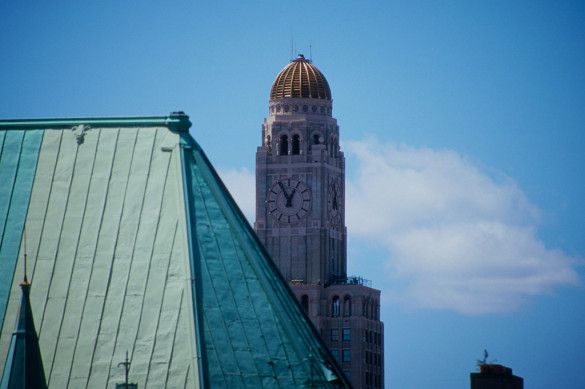Everything You Ever Wanted To Know About Daylight Saving Time

BETWEEN THE LINES: It’s time to change — the time.
Daylight Saving Time (DST), the seasonal hourly change, commenced at 2:00 a.m. this past Sunday. Clocks, watches and other timekeeping devices, including computers and home video units, had to be reset one hour ahead — essentially shifting an hour of daylight from the morning to the evening until the first Sunday in November.
For those of you directionally dazed when it comes to fiddling with your timepieces, just remember — you ‘spring’ forward and ‘fall’ back.
Not long after the first of the year, daylight slowly and steadily lingers a little longer since the Sun rises earlier and sets later by as much as 15 minutes throughout the year. [Ed. – Though we all know, the Sun doesn’t actually “rise.”] By mid-winter, daylight remains until 5:00 p.m. This week, the Sun set just before 6:00 p.m. Once the clocks are reset Sunday, dusk will settle in every evening around after 7.
Almost everyone — except perhaps night owls, vampires, thieves and others who covet the cloak of darkness — prefers daylight to Standard Time. The bonus daylight affords time to spend outdoors on pleasant summer evenings doing things commonly handicapped by darkness. Besides, most of us, with the exception of the sleep-deprived, are asleep as night passes.
With energy consumption as the primary objective, President Bush signed the Energy Policy Act of 2005, which expanded Daylight Saving Time. Beginning in 2007, DST began on the second Sunday in March and ended the first Sunday of November. Besides saving energy, other motives included crime reduction and automobile fatalities, which studies found to occur more often at night.
Three years later, adhering to the legislative directive, the Department of Energy studied the energy savings and found that during daylight saving time, electricity use decreased by 0.5 percent per day, which added up to 1.3 billion kilowatt-hours, enough to power about 122,000 average U.S. homes for a year.
After the law was passed, most consumer electronic items, which were pre-programmed for the old time change date, had to be manually adjusted to compensate for the new modifications. Such is one of the many dilemmas with which we cope to benefit from modern technology.
The backstory for Daylight Saving Time began in 1784 with Benjamin Franklin, the wise statesman and prolific inventor, who was among the first to suggest it in America. His inspiration came when he was the U.S. Ambassador to France. The French introduced it in order to conserve the cost for merchants of almost 100 million pounds of candles a year.
But the concept wasn’t brought to fruition until a British architect proposed it in 1907 and the Germans, whose devotion to precision seems to be genetic, first tried it during World War I. Many other countries soon adopted it. President Woodrow Wilson repealed America’s mandatory daylight saving law on March 31, 1918 when the fuel-saving effort, for which it was instated, never materialized.
Daylight time was again the impetus for fuel economy during World War II on a year-round basis. In fact, the U.S. and other countries employed “double” daylight saving time consisting of a two-hour shift during the Second World War. During the Arab oil embargo of 1973-74, daylight time was again implemented year-round as a fuel consumption measure. In late 1974, as the crisis subsided, standard time returned.
Daylight Saving Time was delayed as standard policy for almost 50 years because America’s once-powerful farm lobby objected and Congress heeded that resistance.
All states currently observe Daylight Saving Time, except for Arizona and Hawaii and the U.S. territories of American Samoa, Guam, Puerto Rico and the Virgin Islands. Arizona regularly has more than a fair share of sun so its citizens presumably crave that extra hour after the sun goes down year-round. Nevertheless, the state’s Navajo Reservation, which extends through three states, switches to Daylight Saving Time, but the smaller Hopi Reservation does not. Must be a tribal thing.
As we age and time seems to pass more quickly, we tend to treasure each day more. Even though Daylight Saving Time doesn’t change the number of hours in a day, it adds more daylight to our lives and that can be a psychological boost.
In any case, what’s an hour, more or less, out of 8,760 each year?
Neil S. Friedman is a veteran reporter and photographer, and spent 15 years as an editor for a Brooklyn weekly newspaper. He also did public relations work for Showtime, The Rolling Stones and Michael Jackson. Friedman contributes a weekly column called “Between the Lines” on life, culture and politics in Sheepshead Bay.
Disclaimer: The above is an opinion column and may not represent the thoughts or position of Sheepshead Bites. Based upon their expertise in their respective fields, our columnists are responsible for fact-checking their own work, and their submissions are edited only for length, grammar and clarity. If you would like to submit an opinion piece or become a regularly featured contributor, please e-mail nberke [at] sheepsheadbites [dot] com.



